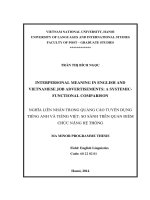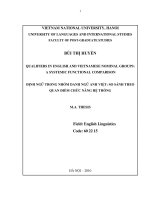Material process in “The old man and the sea” by Hemingway and its Vietnamese translated version A Systematic Functional Comparison
Bạn đang xem bản rút gọn của tài liệu. Xem và tải ngay bản đầy đủ của tài liệu tại đây (329.47 KB, 6 trang )
Material process in “The old man and the sea”
by Hemingway and its Vietnamese translated
version: A Systematic Functional Comparison
43 p.
Quá trình vật chất trong bản gốc và bản dịch tác phẩm ‘Ông già và biển cả của Hemingway
Đặng Thị Phương Mai
Trường Đại học Ngoại ngữ
Luận văn ThS. Chuyên ngành: Linguistics English; Mã số: 60 22 15
Người hướng dẫn: Prof. Dr. Hoang Van Van
Năm bảo vệ: 2011
Abstract: In this study, an attempt is made to explore whether such categories as the
number, configurations, voice and tense of material processes in the translation of the
written extract from “The old man and the sea” by Lê Huy Bắc are equivalent to those in
the original by Hemingway. The data analysis is based on the framework of Halliday’s
(1994) and Hoàng Văn Vân’s (2002). The conclusion claims that there exists both
analogies and deviations in the translation in comparison with the original. However, the
deviations are inevitable due to the fact that each country has its own linguistic and
cultural features. It is undeniable that the translator tried to keep the target text equivalent
to the source text as much as possible. Moreover, it is vital for translators of literature to
pay much attention to linguistic features and cultural contexts, the author’s individual
style and the genre of the text he or she is going to translate.
Keywords: Hemingway; Biên dịch; Tác phẩm văn học; Tiếng Anh
Content
CHAPTER I
INTRODUCTION
1.1. Rationale of the study
Not until I had pursued Master degree of Applied Linguistics at Hanoi University of Languages
and International Studies, did I have the first chance to familiarize myself with one of the most
important schools of linguistics, which is so-called “Functional Grammar” from Professor Hoang
Van Van’s lectures. This type of grammar deeply impressed me especially when it was brought
into comparison with another well-known subtype of grammar; that is, Traditional Grammar.
I got to know Traditional Grammar, through its simple grammatical rules from my first days of
the 6
th
grade. When I studied at the university, it seemed that I was fully aware of the notion
“Traditional Grammar”. Williams (2005) defined the Traditional Grammar as “the collection of
prescriptive rules and concepts about the structures of language that is commonly taught in
schools”. This means that Traditional Grammar refers to ways of analyzing words into such
functions as Subject (S), Verb (V), Object (O), Complement (C) and Adverbial (A) and
analyzing sentences basing on seven major clause types: SV, SVO, SVC, SVA, SVOO, SVOC
and SVOA. All of these rules are presented clearly by Quirk et al. (1985) in “A Comprehensive
Grammar of the English Language”. All in all, this kind of grammar takes linguistic structures
as its priority; therefore, it has limitations on interpreting the organization of a discourse. As a
result, Functional Grammar or Systemic Functional Grammar was developed by the linguist
Halliday in the 1960s in order to solve the problems of discourse analysis.
In fact, a functional grammar was designed to study the wording and interpret the wording by
reference to what it means (Halliday, 1994). In detail, it is particularly helpful for explaining how
language is selected and organized in particular ways for particular socio-cultural purposes.
Three important variables are Field (subject matter), Tenor (roles and relationships), and Mode
(mode and medium). Other Systemic Functional Grammar terms which people might have
approached include circumstance, participant and process. Moreover, Systemic Functional
Grammar is useful for explaining the structuring of clauses, sentences, texts, discourses by
analyzing their cohesive devices. Among all of these categories, what I am most interested in is
types of process in general and material process in particular since material process is a popular
process in English. So I have decided to choose “material process” as the topic of my minor
thesis.
In addition, functional grammar has been studied by many famous linguists in the world like
M.A.K. Halliday (1985, 1994), Bloor (1995), Eggins (1994) and Thompson (1996); among all
of whom, Halliday is considered to be a vanguard grammarian because of his great contributions.
In Vietnam, firstly Cao Xuân Hạo and then Hoàng Văn Vân did researches on Vietnamese in the
light of systemic functional grammar. Their studies respectively are Tiếng Việt – Sơ thảo ngữ
pháp chức năng (1991) and Ngữ pháp kinh nghiệm của cú Tiếng Việt: mô tả theo quan điểm
chức năng hệ thống (2002), in which types of process especially material process in Vietnamese
are investigated. Thus, however small my study is, I myself would like to contribute to this
fledgling field by examining material process through both English and Vietnamese using the
same theoretical framework – systemic functional linguistics.
The functional comparison between material process in English and Vietnamese was carried out
by Huỳnh Thị Cẩm Nhung in 2002. However, in my opinion, the scope of this thesis is rather
broad because the analysis is not attached to any specific texts or discourses. As far as I am
concerned, I have chosen to compare material process in an extract from “The old man and the
sea” by Earnest Hemingway and its Vietnamese translated version by Lê Huy Bắc for three
reasons. Firstly, I find myself have a passion for literature. Secondly, in order to compare items
in two languages, it is vital to show that they are contextually equivalent. Such equivalence can
be best achieved by reference to translation as “translation is the replacement of textual material
in one language by equivalent textual material in another language” (Cartford, 1965). In the
end, assuming English to be the control language and Vietnamese to be the comparative one, the
comparison will become easier and more effective if I compare the translation which is translated
by an experienced and excellent linguist and has won public recognition with the original.
From all reasons above, it is hoped that this study will provide some insights into the
understanding of the translation of material process in literature.
1.2. Aims of the study
The aim of this study is to answer the following questions:
a. What is material process?
b. Are Material processes in the original extract from “The old man and the sea” written by
Hemingway the same as those in its Vietnamese translated version?
c. What implications of translation equivalence does the study have for Vietnamese teachers,
students and translators of literary works?
In order to find the answers to the research questions above, an attempt is made to examine how
material process is conceptualized in English and Vietnamese by synthesizing the works of
Halliday (1994) and Hoàng Văn Vân (2002).
So as to make the comparison between the original and translated version, Halliday’s and Hoàng
Văn Vân’s theoretical framework are chosen to be the descriptive framework of my study.
Finally, basing on the findings of the study, I would like to offer some implications for
translating material process in literature into Vietnamese.
1.3. Scope of the study
1.3.1. The theoretical framework
In this study, I do not have an ambition to cover all aspects of functional grammar. Only issues
related to material process such as framework, elements and features are taken into
consideration.
Moreover, material process is a small domain in a grammatical space which is known as transitivity. In
fact, the Systemic Functional Linguistic model of language recognizes three social functions:
ideational, interpersonal and textual. Among them, ideational function is divided into experiential and
logical. Experiential function is realized by transitivity system. As a result, metafunctions, the grammar
of experience and its representation in the transitivity system are also examined briefly.
1.3.2. The chosen text
The scope of investigation is limited to the written extract from Hemingway’s novella “The old
man and the sea” and, equivalently, its Vietnamese version which is translated by Lê Huy Bắc.
The original extract is from page 88 to 94 and the translated version is from page 64 to 70 of the
whole story. However, during the process of analysis, I have cut down some unnecessary clauses
so that I can analyze the text more easily. As a result, the chosen text in both languages has
shrunk (from 6 to 4 pages).
The reason is that there is not enough space for a minor thesis to investigate the whole novella of
more than 125 pages. An extract of only 4 pages seems to be more feasible. Furthermore, this
extract is about the old man’s fierce battle with a giant marlin on the sea. So, it is supposed to
contain a high density of verbs of action which are frequently the representation of material
process – process of DOING.
This study is confined to an analysis at clause-level.
1.4. Methods and data of the study
From these aims above, the study is carried out basing mainly on two methods: descriptive and
comparative. The former concerns with the description of material process in English and
Vietnamese and the latter concerns with the comparison of the process in the two languages.
As I have said above, the data used for the study are taken from page 88 to 94 of the source
language text and the corresponding pages in the Vietnamese version. The analysis of the source
language text’s clause is based on Halliday’s theory (1994). The investigation of the translated
text is based on both Halliday’s and Hoàng Văn Vân (2002)’s theory.
1.5. Design of the study
This thesis is designed in five chapters:
Chapter I: introduces rationale, aims, scope and methodology of the study
Chapter II: provides the theoretical orientations for the study: systemic functional theory and its
related issues to the topic of my thesis.
Chapter III: discusses some basic notions of material process such as Actor, Goal and
Circumstance.
Chapter IV: is concerned with the comparative analysis between participants, process and
circumstances of material process in English and Vietnamese.
Chapter V: tries to reach the most clear-cut possible conclusions about the equivalence between
the two versions and provides some implications for translation task.
REFERENCES
A. ENGLISH
1. Bloor, T & Bloor, M. (1995). The Functional Analysis of English. London: Arnold.
2. Cartford, J.C. (1965). A Linguistic Theory of Translation. Oxford University Press.
3. Halliday, M.A.K. (1970). Language Structure and Language Function. (In) New Horizon in
Linguistics. Lyons, J. (Ed.). Hamondsworth: Penguin.
4. Halliday, M.A.K. (1978). Language as Social Semiotic. London and Baltimore: Edward Arnold.
5. Halliday, M.A.K & Hasan, R. (1985). Language, Text and Context: a social semiotic
perspective. Vic. Gleelong: Deakin University Press.
6. Halliday, M.A.K. (1994). An Introduction to Functional Grammar. London: Arnold. 7.Eggins,
S. (1994). An Introduction to Systemic Functional Linguistics. London: Pinter.
8. Halliday, M.A.K and Matthiessen, C. (1997). Systemic Functional Grammar: A First Step into
the Theory. Sydney: Macquarie University.
9. James, W. (2005). The Teacher's Grammar Book. Lawrence Erlbaum
10. Martin, J.R. (1985). Systemic Functional Linguistics and an Understanding of written texts.
Department of Linguistics, University of Sydney.
11. Martin, J.R & Rose, D. (2003). Working with Discourse: Meaning beyond the Clause.
Continuum International Publishing Group.
12. Martin, J.R, Matthiessen, C. & Painter, C. (1997). Working with Functional Grammar.
London: Arnold.
13. Nhung, Huỳnh. T. Cẩm. (2002). The Grammar of Material process in English and
Vietnamese: A Functional Comparison (MA Thesis).
14. Plimpton, G. (1961). An Interview with Earnest Hemingway in Baker, C. (1961). Hemingway
and his Critics. Hill and Wang Press.
15. Quirk, R. et al. (1985). A Comprehensive Grammar of the English Language, London:
Longman.
16. Teich, E. (1999). Systemic functional grammar in natural language generation: linguistic
description and computational representation. Continuum International Publishing Group.
17. Thompson, G. (1996). Introducing Functional Grammar. London: Arnold.
B. VIETNAMESE
1. Ban, Diệp Quang. (2002). Ngữ pháp Tiếng Việt, tập 1. Hà Nội: NXB Giáo dục.
2. Cẩn, Nguyễn Tài (1999). Ngữ pháp Tiếng Việt. Hà Nội: NXB Đại học Quốc gia.
3. Hạo, Cao Xuân. (1991). Tiếng Việt: Sơ thảo Ngữ pháp chức năng, quyển 1. Hà Nội: Khoa học
xã hội.
4. Quang, Nguyễn. (2000). Giao thoa văn hóa nhìn từ góc độ hoạt động giao tiếp lời nói.
5. Vân, Hoàng Văn. (2000). Ngữ pháp kinh nghiệm của cú Tiếng Việt: Mô tả theo quan điểm
chức năng hệ thống. Hà Nội: Khoa học Xã hội.









